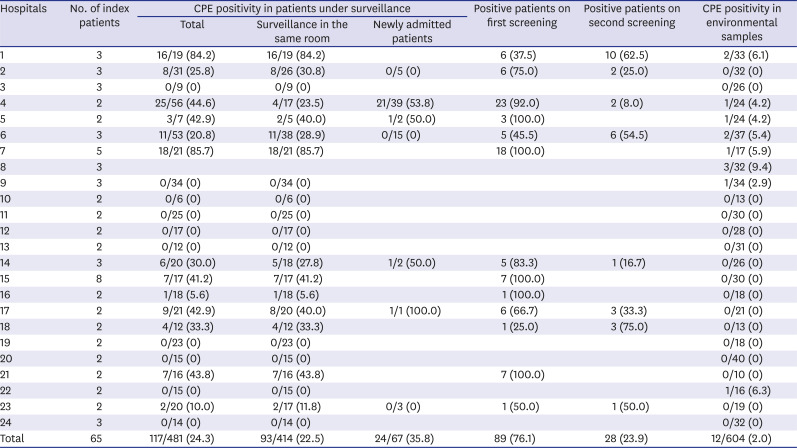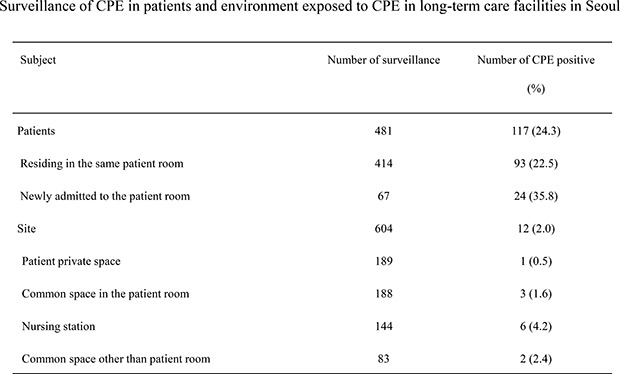1. Nordmann P, Cuzon G, Naas T. The real threat of
Klebsiella pneumoniae carbapenemase-producing bacteria. Lancet Infect Dis. 2009; 9(4):228–236. PMID:
19324295.
2. Nordmann P, Naas T, Poirel L. Global spread of carbapenemase-producing
Enterobacteriaceae
. Emerg Infect Dis. 2011; 17(10):1791–1798. PMID:
22000347.
3. Tumbarello M, Trecarichi EM, De Rosa FG, Giannella M, Giacobbe DR, Bassetti M, et al. Infections caused by KPC-producing
Klebsiella pneumoniae: differences in therapy and mortality in a multicentre study. J Antimicrob Chemother. 2015; 70(7):2133–2143. PMID:
25900159.
7. Brolund A, Lagerqvist N, Byfors S, Struelens MJ, Monnet DL, Albiger B, et al. Worsening epidemiological situation of carbapenemase-producing
Enterobacteriaceae in Europe, assessment by national experts from 37 countries, July 2018. Euro Surveill. 2019; 24(9):1900123.

8. Chotiprasitsakul D, Srichatrapimuk S, Kirdlarp S, Pyden AD, Santanirand P. Epidemiology of carbapenem-resistant
Enterobacteriaceae: a 5-year experience at a tertiary care hospital. Infect Drug Resist. 2019; 12:461–468. PMID:
30863128.
9. Tran DM, Larsson M, Olson L, Hoang NTB, Le NK, Khu DTK, et al. High prevalence of colonisation with carbapenem-resistant
Enterobacteriaceae among patients admitted to Vietnamese hospitals: risk factors and burden of disease. J Infect. 2019; 79(2):115–122. PMID:
31125639.
10. Won SY, Munoz-Price LS, Lolans K, Hota B, Weinstein RA, Hayden MK, et al. Emergence and rapid regional spread of Klebsiella pneumoniae carbapenemase-producing
Enterobacteriaceae
. Clin Infect Dis. 2011; 53(6):532–540. PMID:
21865189.
11. Hong SK, Yong D, Kim K, Hong SS, Hong SG, Khosbayar T, et al. First outbreak of KPC-2-producing
Klebsiella pneumoniae sequence type 258 in a hospital in South Korea. J Clin Microbiol. 2013; 51(11):3877–3879. PMID:
24006005.
12. Go E, Ju SJ, Park S, Yoo J, Hwang KJ. Distributions of carbapenem-resistant Enterobacteriaceae (CRE) in Korea, 2018. Public Health Wkly Rep. 2019; 12(45):1977–1983.
13. Bhargava A, Hayakawa K, Silverman E, Haider S, Alluri KC, Datla S, et al. Risk factors for colonization due to carbapenem-resistant
Enterobacteriaceae among patients exposed to long-term acute care and acute care facilities. Infect Control Hosp Epidemiol. 2014; 35(4):398–405. PMID:
24602945.
14. Lee HJ, Choi JK, Cho SY, Kim SH, Park SH, Choi SM, et al. Carbapenem-resistant
Enterobacteriaceae: prevalence and risk factors in a single community-based hospital in Korea. Infect Chemother. 2016; 48(3):166–173. PMID:
27659436.
15. Mills JP, Talati NJ, Alby K, Han JH. The epidemiology of carbapenem-resistant
Klebsiella pneumoniae colonization and infection among long-term acute care hospital residents. Infect Control Hosp Epidemiol. 2016; 37(1):55–60. PMID:
26455382.
16. Munoz-Price LS. Long-term acute care hospitals. Clin Infect Dis. 2009; 49(3):438–443. PMID:
19548836.

17. Lin MY, Lyles-Banks RD, Lolans K, Hines DW, Spear JB, Petrak R, et al. The importance of long-term acute care hospitals in the regional epidemiology of
Klebsiella pneumoniae carbapenemase-producing
Enterobacteriaceae
. Clin Infect Dis. 2013; 57(9):1246–1252. PMID:
23946222.
18. Ben-David D, Masarwa S, Fallach N, Temkin E, Solter E, Carmeli Y, et al. Success of a national intervention in controlling carbapenem-resistant
Enterobacteriaceae in Israel's long-term care facilities. Clin Infect Dis. 2019; 68(6):964–971. PMID:
29986007.
19. Hayden MK, Lin MY, Lolans K, Weiner S, Blom D, Moore NM, et al. Prevention of colonization and infection by Klebsiella pneumoniae carbapenemase-producing
Enterobacteriaceae in long-term acute-care hospitals. Clin Infect Dis. 2015; 60(8):1153–1161. PMID:
25537877.
20. Kim BM, Jeon EJ, Jang JY, Chung JW, Park J, Choi JC, et al. Four year trend of carbapenem-resistance in newly opened ICUs of a university-affiliated hospital of south Korea. Tuberc Respir Dis (Seoul). 2012; 72(4):360–366. PMID:
23227077.

21. Huh K, Kim J, Cho SY, Ha YE, Joo EJ, Kang CI, et al. Continuous increase of the antimicrobial resistance among gram-negative pathogens causing bacteremia: a nationwide surveillance study by the Korean Network for Study on Infectious Diseases (KONSID). Diagn Microbiol Infect Dis. 2013; 76(4):477–482. PMID:
23721721.

22. Kim DK, Kim HS, Pinto N, Jeon J, D'Souza R, Kim MS, et al. Xpert CARBA-R assay for the detection of carbapenemase-producing organisms in intensive care unit patients of a Korean tertiary care hospital. Ann Lab Med. 2016; 36(2):162–165. PMID:
26709264.

24. Kim J, Lee JY, Kim SI, Song W, Kim JS, Jung S, et al. Rates of fecal transmission of extended-spectrum β-lactamase-producing and carbapenem-resistant Enterobacteriaceae among patients in intensive care units in Korea. Ann Lab Med. 2014; 34(1):20–25. PMID:
24422191.

25. Kang JS, Yi J, Ko MK, Lee SO, Lee JE, Kim KH. Prevalence and risk factors of carbapenem-resistant
Enterobacteriaceae acquisition in an emergency intensive care unit in a tertiary hospital in Korea: a case-control study. J Korean Med Sci. 2019; 34(18):e140. PMID:
31074254.

26. Park JW, Kwak SH, Jung J, Lee JY, Lim YJ, Choi HS, et al. The rate of acquisition of carbapenemase-producing
Enterobacteriaceae among close contact patients depending on carbapenemase enzymes. Infect Chemother. 2020; 52(1):39–47. PMID:
32114721.
27. Hwang JH, Park JS, Lee E, Bae JY, Song KH, Choe PG, et al. Active surveillance for carbapenem-resistant
Enterobacteriaceae, vancomycin-resistant enterococci and toxigenic
Clostridium difficile among patients transferred from long-term care facilities in Korea. J Hosp Infect. 2018; 99(4):487–491. PMID:
29476883.
28. Blanco N, O'Hara LM, Harris AD. Transmission pathways of multidrug-resistant organisms in the hospital setting: a scoping review. Infect Control Hosp Epidemiol. 2019; 40(4):447–456. PMID:
30837029.









 PDF
PDF Citation
Citation Print
Print




 XML Download
XML Download